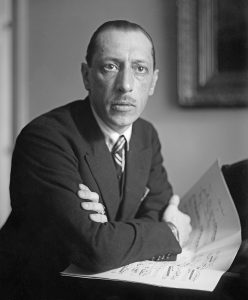4. Primitivism

The brilliant Igor Stravinsky (1882–1971) was truly a cosmopolitan figure, having lived and composed in Russia, France, Switzerland, and the United States. His music influenced numerous composers, including the famed French composition teacher Nadia Boulanger. Stravinsky caused quite a stir when the ballet entitled Le Sacre du printemps (The Rite of Spring) premiered in Paris in 1913. He composed the music for a ballet that was choreographed by Sergei Diaghilev, and it was so new and different that it nearly caused a riot in the audience. The orchestral version (suite) has become one of the most admired compositions of the 20th century.
Stravinsky’s use of “primitive” sounding rhythms to depict several pagan ritual scenes makes the term “primitivism” seem appropriate.
Focus Composition: Sacrificial Dance from The Rite of Spring
Listening Guide
Joffrey Ballet, the 1987 Nijinsky Reconstruction, by Millicent Hodson and Kenneth Archer; Orchestra of the National theatre, Prague, conducted by Allen Lewis; Beatriz Rodriguez as The Chosen One
Composer: Igor Stravinsky (1882–1971)
Composition: Sacrificial Dance, The Rite of Spring
Date: premiered in 1913
Genre: ballet music
Form: specific passages accompany changes in choreography
Performing Forces: full orchestra
The Scene: The Chosen One dances to death in the presence of the old men.
| Timing | Performing Forces, Melody, and Texture |
| 0:05 | Strings: string section with percussion; short, hard notes, irregular rhythms |
| 0:36 | Strings; winds and soft plucked-string accompaniment |
| 0:49 | Trombones; winds and soft plucked-string accompaniment; triplet trombone fanfare over plucked string parts; muted trumpets and strings answer; timpani |
| 0:58 | Strings; then plucked-string accompaniment becoming loud |
| 1:11 | Trumpet fanfare; plucked-string accompaniment remaining loud |
| 1:20 | French horns joining fanfare section; plucked-string accompaniment remaining loud |
| 1:27 | Plucked-string accompaniment becomes the melody. |
| 1:37 | Winds and soft plucked-string accompaniment |
| 1:52 | Violins; and scale patterns become very fast and loud. |
| 2:04 | Silence |
| 2:06 | Strings and percussion; restatement of the section at 0:05 |
| 2:36 | Brass and percussion; percussion becoming faster and louder |
| 3:03 | Horn riffs up to high notes; high clarinet added |
| 3:12 | Silence |
| 3:13 | Strings and percussion; restatement of the section at 0:05 |
| 3:19 | Full orchestra; multiple loud fanfare-like parts in many sections; building up |
| 3:42 | Strings; similar to 0:05 but more intense |
| 4:19 | Brass; full orchestra; and rhythmic figures carry the intensity of the dance to end. |
A musical movement that arose as a reaction against musical impressionism and which focused on the use of strong rhythmic pulse, distinct musical ideas, and a tonality based on one central tone as a unifying factor instead of a central key or chord progression.
